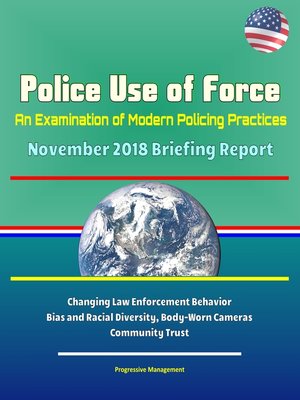Police Use of Force
ebook ∣ An Examination of Modern Policing Practices--November 2018 Briefing Report--Changing Law Enforcement Behavior, Bias and Racial Diversity, Body-Worn Cameras, Community Trust

Sign up to save your library
With an OverDrive account, you can save your favorite libraries for at-a-glance information about availability. Find out more about OverDrive accounts.
Find this title in Libby, the library reading app by OverDrive.



Search for a digital library with this title
Title found at these libraries:
| Library Name | Distance |
|---|---|
| Loading... |
This report has been professionally converted for accurate flowing-text e-book format reproduction. In this report, the Commission investigated rates of police use of force; whether rates and instantiations of that use of force violate civil rights of persons of color, persons with disabilities, LGBT communities, and low-income persons; promising or proven policies and practices worth replicating to minimize unnecessary use of force; and the perception and reality of discrimination in police use of force. The Commission considered evidence from law enforcement and court officials, community leaders and police reform advocates, scholars, legal experts, as well as testimony taken in by the Commission's State Advisory Committees in Minnesota, New York, Maine, and Delaware. The Commission majority approved key findings including the following: While police officers have the difficult and admirable job of providing crucial services to the communities they protect and serve, their job sometimes puts them in harm's way and may require the use of force. Accordingly, police officers must operate with the highest standards of professionalism and accountability. Every community resident should be able to live, work, and travel confident in an expectation that interactions with police officers will be fair, consistent with constitutional norms, and guided by public safety free from bias or discrimination. Unfortunately, too many communities are not confident in these expectations, and so these communities have called for reforms to foster better community-police relations and prevent unjustified and excessive police uses of force. Accurate and comprehensive data regarding police uses of force is generally not available to police departments or the American public. No comprehensive national database exists that captures police uses of force. The best available evidence reflects high rates of uses of force nationally, with increased likelihood of police use of force against people of color, people with disabilities, LGBT people, people with mental health concerns, people with low incomes, and those at the intersection of these communities. Lack of sufficient training—and funding for training—leaves officers and the public at risk. Repeated and highly publicized incidents of police use of force against persons of color and people with disabilities, combined with a lack of accurate data, lack of transparency about policies and practices in place governing use of force, and lack of accountability for noncompliance foster a perception that police use of force in communities of color and the disability community is unchecked, unlawful, and unsafe.
EXECUTIVE SUMMARY * Highlighted Findings * Highlighted Recommendations * Chapter 1: Introduction: Definitions, Data, and Major Theoretical Perspectives * Defining Excessive Use of Force * State of National Data Collection * Existing Data on Lethal and Non-Lethal Use of Force * Disparities in Use of Force * Explanations for and Analysis of Rates of Police Use of Force * Inevitability Argument * Systemic Perspectives * Chapter 2: Police Oversight And Accountability * Internal Accountability * Body-Worn Cameras * External Oversight * Civilian Review Boards * Grand Juries * Qualified Immunity * Consent Decrees * Chapter 3: Changing Law Enforcement Behavior * A Holistic Approach to Reforming the Overall Policing System * Racial Diversity * Training * Implicit Bias Training * De-escalation Training * Mental Health and Disability Training * Building Community Trust * Chapter 4: Findings and Recommendations * Findings * Community Trust * Data * Training * Accountability * Recommendations * Commissioners' Statements,...







